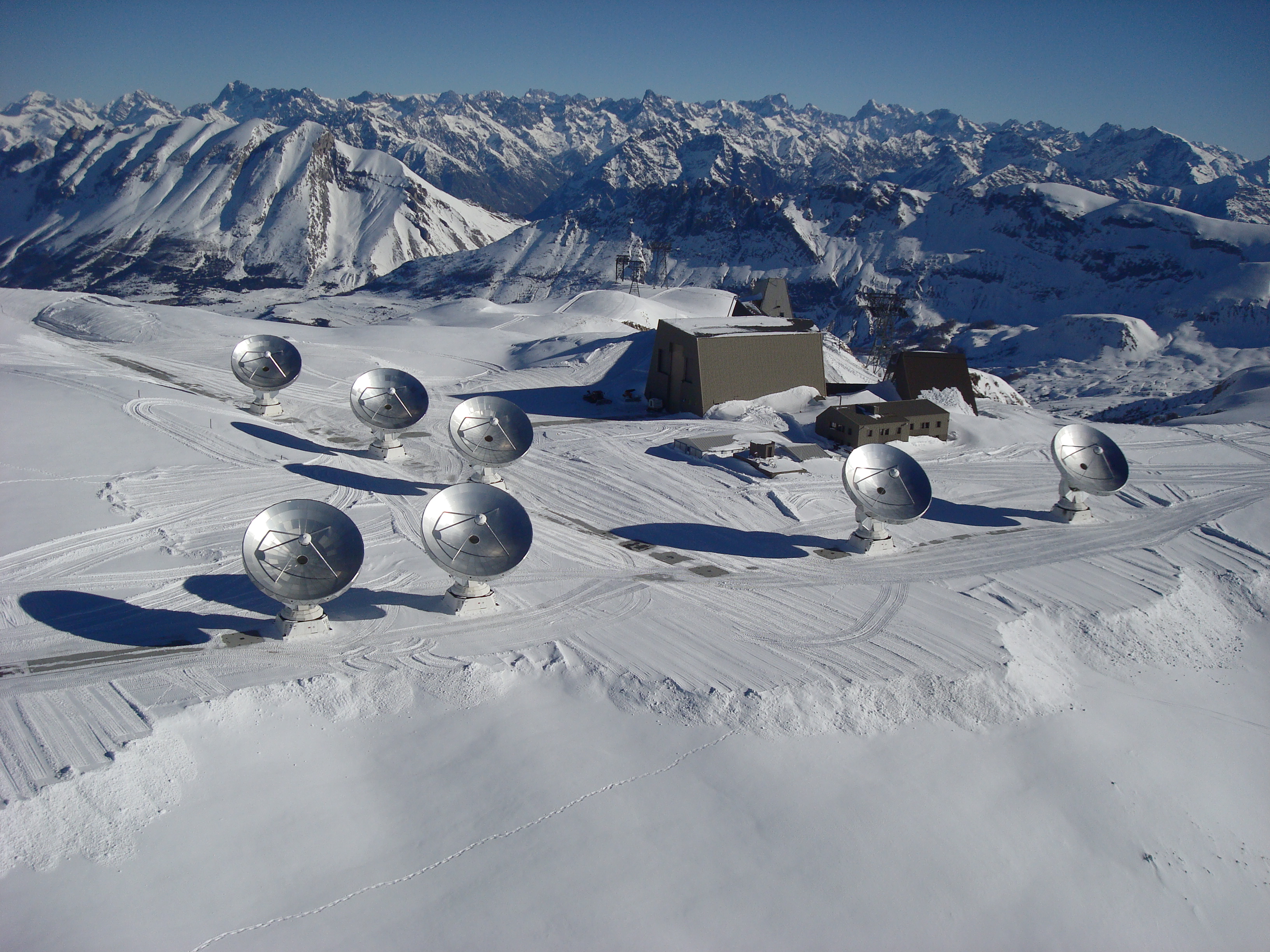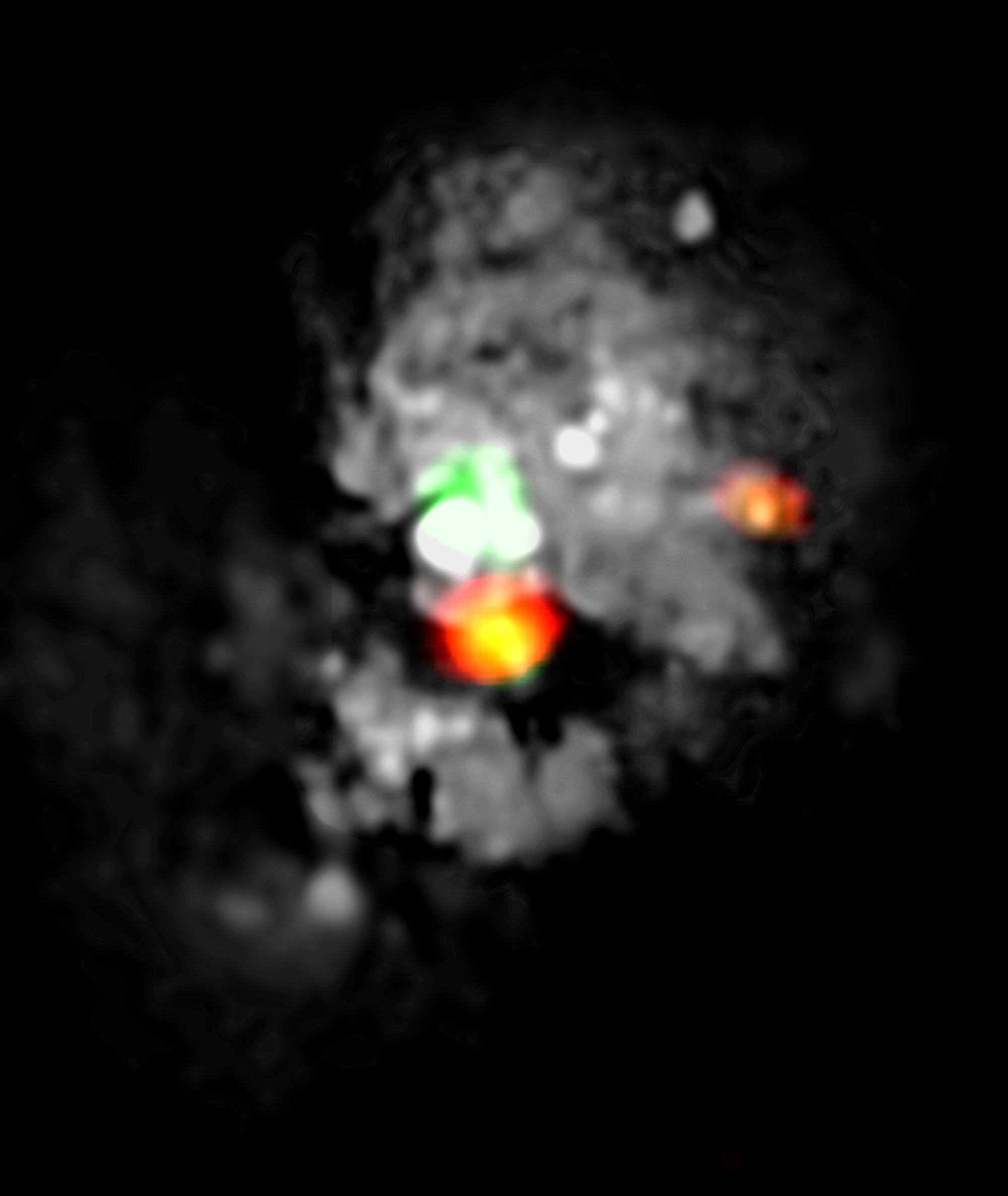News
NOEMA discovers previously unknown extreme star formation region - the ‘Eye of Medusa’
Pioneering technique using powerful new radio telescope expands our understanding of chemical formation of stars
NOEMA (Northern Extended Millimeter Array), the most powerful millimetre radio telescope of the Northern Hemisphere, has unveiled its first astronomical image: a unique and spectacular view of a previously unknown region of extreme star formation in the ‘Medusa merger’ – a luminous collision of two galaxies at more than 100 million light years from Earth.
 |
| Located in the French Hautes-Alpes on the Plateau de Bure, NOEMA currently consists of seven antennas, each 15 meters in diameter. Credits : André Rambaud/IRAM |
The observations, conducted by IRAM using the new NOEMA observatory in the French Alps, reveal a giant region (about 500 light years across) of recently formed massive stars at the center of the ‘Eye of Medusa’, the central gas-rich region of the Medusa merger. The stars are still wrapped in their dusty birth clouds and completely hidden from view in visible light.
Other observatories have previously mapped the Medusa merger but none had detected the existence of this region of high-density gas in the ‘Eye’ until now. The new discovery has not only proven its existence, but also has implications for our understanding of the origins of the Universe and will influence future investigative techniques.
Previous exploration of the Medusa merger had involved carbon monoxide (CO) – the most common molecule used in radio observations at millimeter wavelengths. Observations of this molecule had never before revealed any detail of a potential ‘Eye’ region. The IRAM team, led by Sabine Koenig, tried a new way in, tuning the NOEMA antennas to detect hydrogen cyanide (HCN) and formylium (HCO+) molecules.
The discovery demonstrates that star development can be probed in stages of formation, which are currently not detectable by tracing carbon monoxide. By successfully detecting other molecules, the extreme star formation observed in the ‘Eye’ demonstrates the existence of more complex chemical formulations than previously thought. This discovery means our understanding of the chemical formation of stars can be hugely expanded upon.
Studies on galaxy collisions and their impact on star formation are fundamental to understanding how galaxies have assembled throughout the history of the Universe.
Sabine Koenig of IRAM, who led the team of researchers in the discovery, said, "It was a great surprise to see this region brightly illuminated all of a sudden, and see it shine with the light of thousands of recently formed stars. This region turns out to be the site of the most extreme stellar nursery in this galactic collision!”
 |
| Thanks to the NOEMA observatory, astronomers have detected a very active region of extreme star formation in the “Medusa merger” (NGC 4194). The multi-wavelength image shows the "Eye of Medusa" (orange) located directly below the black hole at the center of NGC 4194 (white and green here). Credits: IRAM/NASA/ESA Hubble Space Telescope, Hubble Legacy Archive |
Roberto Neri, Scientific Director of the NOEMA observatory, said, "These observations clearly show that we have perfectly mastered the new instrument and that NOEMA will allow us to uncover and explore the complex process of star formation in the most hidden places of our Universe in the coming years”.
NOEMA is the result of an international effort and will operate in synergy with the largest and most important astronomical instruments on Earth and in space. It can probe the cold universe (around -250 degrees Celsius) and detect the cold interstellar matter (gas and dust), which is responsible for the formation of new stars and planets. It is part of a new generation of radio telescopes employing the most advanced technologies available. Although still under construction, this instrument is already the most powerful millimeter wave interferometer in the Northern Hemisphere.
NOEMA is the result of considerable development of the previous Plateau de Bure observatory, which became NOEMA when the first of six new antennas was inaugurated in September 2014. It is currently operating with seven antennas of 15 metres diameter, each equipped with a unique and ultra-sensitive receiver system, approaching the quantum limit. It will ultimately be equipped with 12 antennas, giving the international scientific community an exceptional look into the depths of our Universe through hundreds of scientific research projects each year.
NOEMA will be one of the leading instruments in the hunt for astronomical discoveries in the most remote regions of our Universe and its capabilities will ultimately contribute to human understanding of the evolution of the universe.
Read also the Max-Planck-Society press release (in German) and the CNRS and INSU press releases (in French).
More information:
IRAM
IRAM, (Institut de Radioastronomie Millimetrique, founded 1979) is an international research institute based on a long-term collaboration between the French CNRS (Centre National de la Recherche Scientifique), the German MPG (Max-Planck Gesellschaft) and the Spanish IGN (Instituto Geografico Nacional). IRAM’s headquarters are located in Grenoble and the institute maintains and develops two observatories: the 30-m radiotelescope located on Pico Veleta in Spain and the NOEMA Interferometer, situated on the Plateau de Bure in the French Alps, an array which will be equipped with 12 antennas in a near future.
Millimeter Radio Astronomy
Millimeter radio astronomy plays an essential role in modern-day astrophysics and is an essential complement to optical astronomy. Compared to optical astronomy, which is sensitive to the hot universe (stars are generally at a temperature of a few thousand degrees Celsius), radio telescopes that operate in the millimeter wavebands, such as NOEMA, probe the cold universe (around -250 degrees Celsius). Astronomers can thus detect the cold interstellar matter (gas and dust), which is responsible for the formation of new stars and planets. In other words, radio astronomy enables the study of the evolution of the Universe.
NOEMA (Northern Extended Millimeter Array)
NOEMA, currently the largest ground based astronomical project in Europe, represents a total budget of 48 million euros. It is jointly funded by the IRAM partners: CNRS (National Centre for Scientific Research) in France, the MPG (Max Planck Gesellschaft) in Germany and IGN in Spain. Its construction began in 2013 and its completion is scheduled for 2019.
Discover NOEMA on CNRS Le Journal (in French): https://lejournal.cnrs.fr/videos/noema-un-nouveau-regard-sur-linvisible
Contacts
Karin Zacher
IRAM Public Relations Officer
Tel : +33 4 76 82 21 03
Mail : zacher@iram.fr



